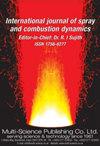Combustion instability modeling using multi-mode flame transfer functions and a nonlinear Euler solver
IF 2.1
4区 工程技术
Q3 ENGINEERING, MECHANICAL
International Journal of Spray and Combustion Dynamics
Pub Date : 2020-09-01
DOI:10.1177/1756827720950320
引用次数: 5
Abstract
Modern methods for predicting combustion dynamics in high-pressure combustors range from high-fidelity simulations of sub-scale model combustors, mostly for validation purposes or detailed investigations of physics, to linearized, acoustics-based analysis of full-scale practical combustors. Whereas the high-fidelity simulations presumably capture the detailed physics of mixing and heat addition, computational requirements preclude their application for practical design analysis. The linear models that are used during design typically use flame transfer functions that relate the unsteady heat addition q ′ to oscillations in velocity and pressure ( u ′ and p ′ ) that are obtained from the wave equation. These flame transfer functions can be empirically determined from measurements or derived from theory and analysis. This paper describes a hybrid approach that uses high-fidelity simulations to generate flame transfer functions along with nonlinear Euler CFD to predict the combustor flowfield. A model rocket combustor that presented a self-excited combustion instability with pressure oscillations on the order of 10% of mean pressure is used for demonstration. Spatially distributed flame transfer functions are extracted from a high-fidelity simulation of the combustor and then used in a nonlinear Euler CFD model of the combustor to verify the approach. It is shown that the reduced-fidelity model can reproduce the unsteady behavior of the single element combustor that was both measured in the experiment and predicted by a high-fidelity simulation reasonably well.使用多模火焰传递函数和非线性Euler求解器的燃烧不稳定性建模
预测高压燃烧室燃烧动力学的现代方法包括从亚比例模型燃烧室的高保真模拟(主要用于验证目的或详细的物理研究)到全尺寸实际燃烧室的线性化、基于声学的分析。虽然高保真度模拟可能捕捉到混合和热添加的详细物理,但计算要求排除了它们在实际设计分析中的应用。在设计过程中使用的线性模型通常使用火焰传递函数,该函数将非定常热量添加q '与从波动方程中获得的速度和压力(u '和p ')的振荡联系起来。这些火焰传递函数可以通过测量经验确定,也可以通过理论和分析得出。本文介绍了一种利用高保真模拟生成火焰传递函数和非线性欧拉CFD预测燃烧室流场的混合方法。用一个模型火箭燃烧室进行了验证,该燃烧室表现出自激燃烧不稳定性,压力振荡在平均压力的10%左右。从燃烧室的高保真仿真中提取空间分布的火焰传递函数,然后将其用于燃烧室的非线性欧拉CFD模型来验证该方法。结果表明,降保真度模型能较好地再现实验测量和高保真度模拟预测的单单元燃烧室的非定常行为。
本文章由计算机程序翻译,如有差异,请以英文原文为准。
求助全文
约1分钟内获得全文
求助全文
来源期刊

International Journal of Spray and Combustion Dynamics
THERMODYNAMICS-ENGINEERING, MECHANICAL
CiteScore
2.20
自引率
12.50%
发文量
21
审稿时长
>12 weeks
期刊介绍:
International Journal of Spray and Combustion Dynamics is a peer-reviewed open access journal on fundamental and applied research in combustion and spray dynamics. Fundamental topics include advances in understanding unsteady combustion, combustion instability and noise, flame-acoustic interaction and its active and passive control, duct acoustics...
 求助内容:
求助内容: 应助结果提醒方式:
应助结果提醒方式:


